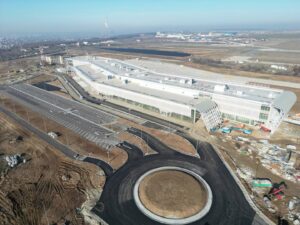In the winter holiday season we may need the magic of Santa Claus to see the store shelves full. Clothing and footwear, in particular, could be found in limited stock due to production and shipping issues. And this is a global problem that will also affect Romania, says an analysis by eToro analyst Bogdan Maioreanu.
Urmărește mai jos producțiile video ale Economedia:
- articolul continuă mai jos -
Nike has already sounded the alarm about delivery delays after closing its factories in Vietnam due to the Covid pandemic. The brand has already lost more than 10 weeks of production due to the lockdowns. And the situation is far from resolved.
Nike’s factories in Vietnam have been closed since July, with reopening expected in early October. Nike says it will take “several months” for production to reach full capacity. Even if production is resumed, transport problems pose a serious threat to supply over the holiday season.
Shipping times and costs have continued to worsen throughout the pandemic. The price of shipping containers has risen, while ports remain congested all along the US West Coast. Nike normally expects products to arrive from its factories in 40 days, but now transit times have increased to 80 days. The largest US gateways, which process more than a quarter of imports, the ports of Los Angeles and Long Beach, California, are operating with disruptions due to a shortage of workers and trucks. Tens of thousands of containers are stuck without being processed, and more than 60 ships are queuing to dock, with wait times stretching up to three weeks. And holiday shipments haven’t even started yet.
Nike’s shipping problems are shared by other companies that have proactively tried to solve them. American Eagle Outfitters – a specialty retailer – recently invested in strengthening its supply chain. In late August this year, the company acquired AirTerra, a Seattle-based transportation and logistics startup that is less than a year old. This is the third acquisition American Eagle has made in its 44-year history. The other two – Todd Snyder and Tailgate Clothing – were apparel brands. During its financial results conference call, the company attributed much of the quarter’s record revenue – more than $1 billion, a 35% increase over last quarter – to this investment, as it was able to reduce its lead time by a week and a half. Other steps to get around supply chain issues included ramping up production earlier than normal and diversifying the ports from which it takes product, rather than relying solely on the Port of Los Angeles.
And they’re not alone. Walmart, the world’s largest traditional retailer, is another big company that has invested directly in shipping. Instead of shipping through a third-party service, Walmart began chartering its own ships in July.
Interestingly, some fashion brands have adapted to supply chain issues by redesigning their products. “We designed our [holiday] collection to be more timeless and less seasonal, so that in the event of shipping delays, our product could be sold at full price for a longer period of time, should the need arise,” said Brittney Rothweiler, co-founder of four-year-old fashion brand The Range. Other brands are trying to bring production closer to retail outlets.
Nike could follow Walmart’s lead and try to develop its own shipping company. But factory closures are a much harder challenge to avoid. The size of Nike’s business ($37 billion in 2020) means that rapid production is needed to meet demand. The most likely solution might be to spread its production to more countries. But this will take time. Currently, 80% of the company’s footwear factories are in South Asia. Because of this, Nike lowered its expectations for fiscal 2022, disappointing investors and seeing its share price drop more than $10 from 159.98.

 Sursa foto: Pexels
Sursa foto: Pexels





























